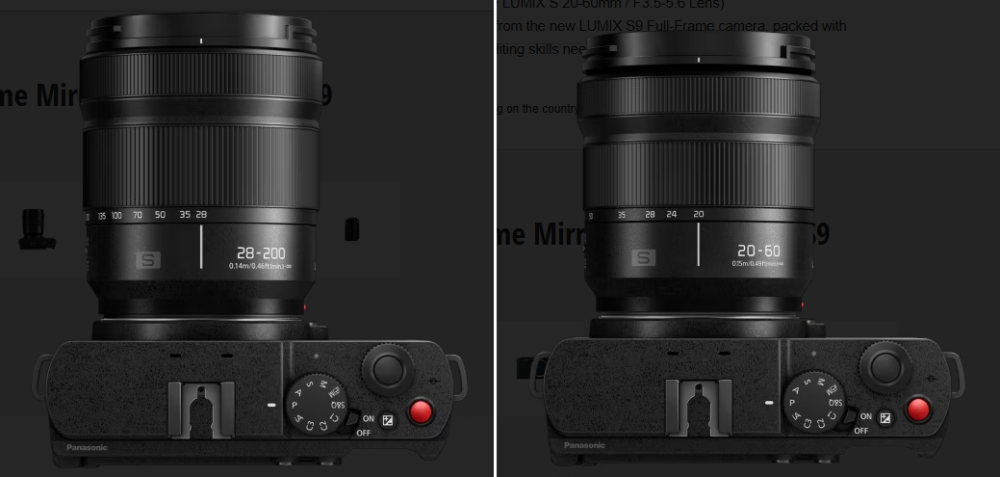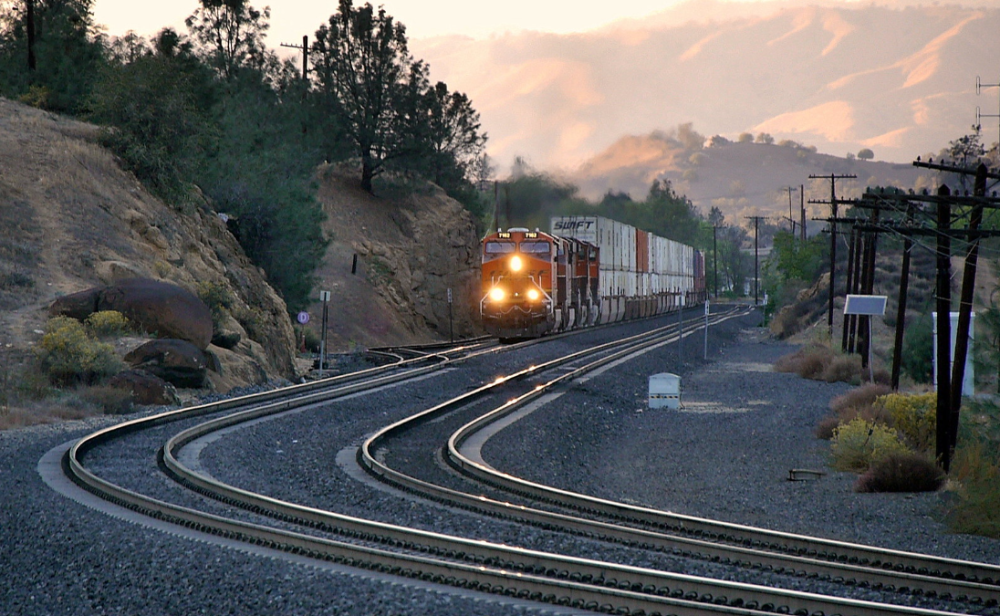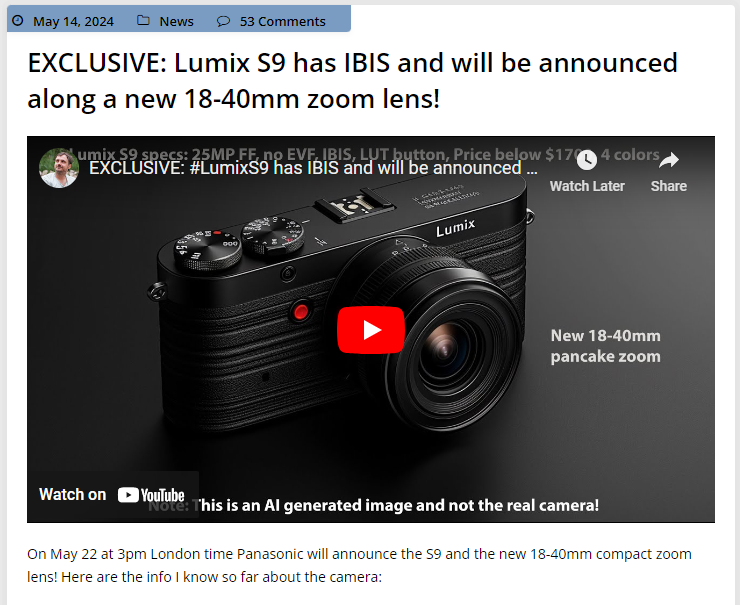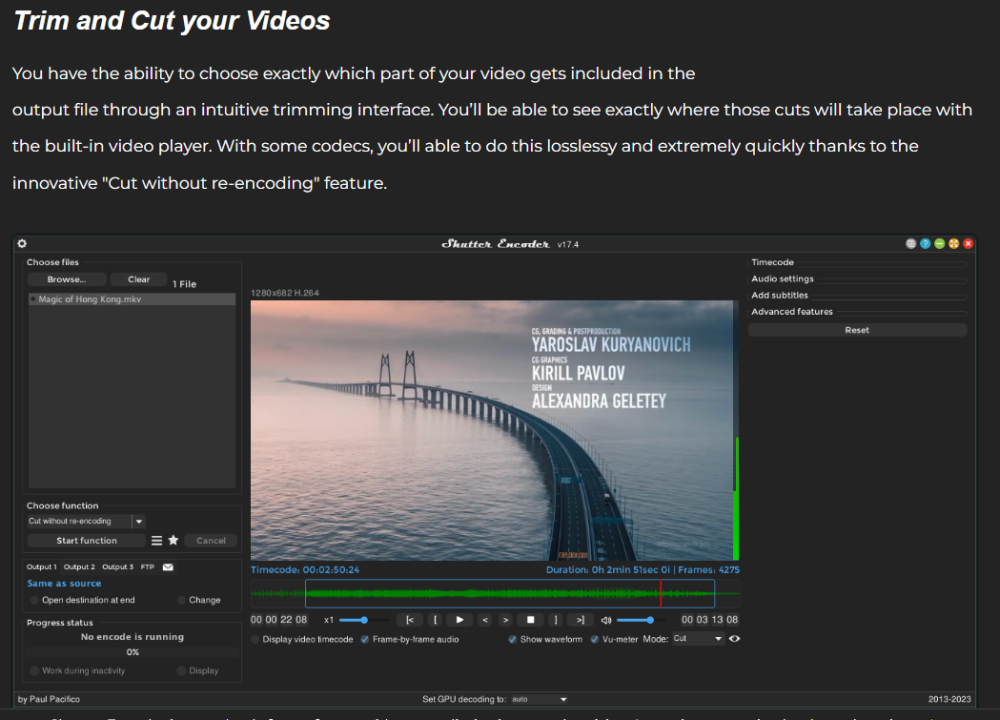
ac6000cw
Members-
Posts
683 -
Joined
-
Last visited
Content Type
Profiles
Forums
Articles
Everything posted by ac6000cw
-
Exactly (GX85 + 14-140mm is my current travel cam). Versus the GX85 or GX9, you get 24MP stills, PDAF, a dual-gain sensor with good high-ISO performance, 4k50p/60p (albeit with a crop but so does the GX85/GX9 in 4k), a higher capacity battery, better stabilization, variable electronic zoom, a mic input, H264 and H26 10-bit recording at (in round numbers) 24/25/30/48/50/60p up to C4K, with higher resolutions up to 30p, at up to 4:2:2 and 200Mbps long-GOP. Viewed as a GX85 & GX9 successor, it makes a lot of sense, especially once the 18-40mm zoom is available. (At the moment, buying used from a dealer in the UK, a GX9 + 14-140mm would cost around £700 - £1000 so that's not a cheap camera either).
-
Panasonic UK have two S9 kits listed on their website, one with the 20-60mm f3.5-5.6, the other with the 28-200mm f4-7.1 Macro OIS lens (but no price as yet for that kit). Comparing the sizes of both on the S9, the 28-200mm kit looks like it might be a nice FF travel cam combination at just under 900g total weight including battery. According to Panasonic W x H x D is 126 x 73.9 x 140.1 mm with the 28-200 (the 20-60 is just 6mm shorter and 63g lighter): Amateur Photographer magazine in the UK has estimated the length of the upcoming compact 18-40mm F4.5-6.3 at around 40mm, which is about half the length of the 20-60mm.
-
It's usually to free up capital tied up in the stock, generate cash to run the company and pay to manufacture new stock of something that is selling better with higher profit margins. Also retailers may get sales volume-based discounts or bonuses from suppliers which are extra income to them.
-
Have a good story to tell that holds the viewers attention. Everything else is secondary, as without that they won't be watching the content for very long anyway.
-
That was Paul Cook - https://vimeo.com/paulcook and https://www.paulcookfilm.com/
-
Lens wise, I think what is needed to pair with the S9 is a collapsible kit zoom like the APS-C Nikon Z 16-50mm f3.5-6.3 but FF so maybe a 24-70mm f4-7.1 ? But as MrSMW said, at the moment a Sigma APS-C 18-50 f2.8 makes a lot of sense for video use as 4k50/60p is APS-C cropped anyway.
-
But that's comparing current 'street' price of S5ii with launch price of S9 - here in the UK the S5ii was around £1999 at launch, £1649 now. I'd expect the S9 to follow the same sort of price curve, by the end of the year it'll probably be at least £200-£300 cheaper (depending on how good sales are). It's pretty obvious that it's designed to be as small and cheap as possible - no mechanical shutter, no headphone jack, no EVF, cold shoe only, minimal dials and buttons. That keeps the build cost down and helps the product cope with 'price erosion' over time. If they were making a more cutting-edge camera it might have a much faster stacked sensor to compensate for the lack of mechanical shutter - but then I suspect everyone would be saying it's nice but way too pricey...
-
From the specs on the Panasonic UK website:
-
When I saw that in one of the videos, I had a sense of déjà vu - some of the old G-series m43 cameras from 10+ years ago had a combined optical plus variable sensor crop zoom system for stills operated by a zoom lever on the body. It was actually quite a nice feature, especially with a power-zoom lens. It was never available for video though. I wonder if the digital zoom feature will be added to the S5ii/iix in a firmware update at some point? As the S9 has no headphone jack, but does have Bluetooth 5.0, why not add basic Bluetooth headphone support to provide some sort of audio monitoring capability? I know there can be latency issues with Bluetooth audio, but it would be a lot better than nothing at all... Personally the lack of a mechanical shutter and the short record times don't bother me, and the variable zoom feature is quite appealing, so I could be tempted when the price drops - I think it's a bit high in comparison with the competition at the moment. BTW the full specs are on the Panasonic website e.g. the UK version - https://www.panasonic.com/uk/consumer/cameras-camcorders/lumix-mirrorless-cameras/lumix-s-full-frame-cameras/dc-s9.html - and most of the standard picture profiles seem to be there (Standard / Vivid / Natural / L. Classic Neo / Flat / Landscape / Portrait / Monochrome / L. Monochrome / L. Monochrome D / L. Monochrome S / LEICA Monochrome / Cinelike D2 / Cinelike V2 / Like709 / V-Log / REAL TIME LUT / Like2100 (HLG) / Like2100 (HLG) Full Range*) so I assume you don't need to mess about with LUTs to get them.
-
4k/UHD video = 8MP stills which I think is perfectly fine even on a large screen at normal viewing distance. One of my favourite photos (which other people have also liked) is only a 2MP JPEG, taken in 2015 with a Pana G6 while simultaneously recording FHD video. It's the light, shade and the sweep of the glinting rails that makes it work, not the resolution:
-
Panasonic S5 II (What does Panasonic have up their sleeve?)
ac6000cw replied to newfoundmass's topic in Cameras
The GX8 (announced in July 2015) was AFAIK the first m43 camera with a 20Mp sensor. I almost bought one at the end of 2015 when Panasonic had a double-cashback promotion running, but didn't as there was no sensor-shift stabilization for video (lens OIS plus EIS for FHD, only lens OIS for 4k), so decided to wait for full video IBIS with dual-IS - eventually buying a G80 when it came out in autumn 2016. That said, whenever I've played with a GX8 in camera stores, I've always liked it (it has a nice 'premium' feel) and thought about buying it used a few times - partly for its large vari-angle viewfinder. -
Panasonic S5 II (What does Panasonic have up their sleeve?)
ac6000cw replied to newfoundmass's topic in Cameras
Yes, but there were quite a lot of adverse review comments about the level of cropping it used, which probably had an adverse effect on sales (for a vlogging targeted camera needing a wide angle of view). I'm sure the S9 will have at least EIS (which Panasonic do very well). If the new 18-40 zoom lens has OIS that might be enough in a dual-IS combination. -
Panasonic S5 II (What does Panasonic have up their sleeve?)
ac6000cw replied to newfoundmass's topic in Cameras
IBIS has been mentioned on l-rumors.com - and personally (given that competition like the a7c ii, ZV-E1 and X100V1 has it) I think it might be a bit suicidal not to include it. -
If you want a nice, free, GUI based tool, 'Shutter Encoder' - https://www.shutterencoder.com/ - uses FFMPEG underneath, supports cutting without re-encoding for some codecs (on keyframe boundaries) and is available for Windows, MacOS and Linux. If you want to re-compress the files to reduce the size, it supports ProRes and many others, including optional GPU hardware acceleration for H264/AVC and H265/HEVC. But always check the new files work properly in your editor before you delete the originals... (I don't have any connection with the tool other than being a satisfied user)
-
Panasonic S5 II (What does Panasonic have up their sleeve?)
ac6000cw replied to newfoundmass's topic in Cameras
As Panasonic are traditionally in the 'high-value' (rather than 'high-price') area of the market, using the Sony 61MP sensor would probably have pushed the price too high. But if the S9 sells well, an S9r would be the obvious spin-off from it. The Sony FF 24MP sensor is almost in the 'bargain basement' area now. It's OK for stills, but it's slow - hence the poor rolling shutter and crop in 4k 50/60p. Maybe an S1H ii might have a much faster FF stacked sensor? - it would be something significant to put it above the S5iix -
The situation with review content being affected by commercial interests is nothing new in the slightest... Many years ago I was asked if I was interested in doing a product review for a now long-gone print magazine. I tried to be as fair as possible when I wrote it, but thought the product had some usability/compatibility issues that needing fixing. The version of the review printed in the magazine had some of my criticism watered-down, I assume partly because advertising revenue related to the product was important to the finances of the magazine. I only did a couple of reviews for the magazine in the end, mostly because the amount they paid for them wasn't much in relation the work involved in testing a product properly (and I wasn't interested in doing quicker, more superficial reviews).
-
Panasonic S5 II (What does Panasonic have up their sleeve?)
ac6000cw replied to newfoundmass's topic in Cameras
A 'walking about in a forest' comparison from Robert May of the S5iix stabilisation modes at 14mm (very wide angle) using the 14-28mm f4-5.6 lens(which doesn't have OIS): Pretty impressive stabilisation performance with minimal warping artefacts. -
A very good strategy for getting the best out of older 8-bit cameras - I think Kye does the same (with a GX85). At the end of the day, unless you tell them, anyone who watches the final movie won't know (or care for the most part) what was used to make it - they'll judge it primarily on the story it tells, be it fictional or documentary, and whether it it's enjoyable/interesting/absorbing. If an old camera does the job and is enjoyable to work with, why not use it? Inanimate tools like cameras, lights and filters can help or hinder the art, but they can't create it...that needs imagination.
-
Capturing in 4k or 1080? I still have and occasionally use a GX80. I recently had a serious clear-out of my most of my older cameras - G6, GX800, E-M1 ii, LX7, LX100 - but did hesitate over the LX7, to the point where I did some video test shots. In the end the amount of jaggies/aliasing and no 4k weighed more heavily than the small size and reasonably 'premium' feel, so it went...
-
Never done any VR stuff, but a few thoughts/ideas: You could try a using stereo mic with a 120 degree (instead of the more usual 90 degree) angle between the capsules. That will give you a wider, more diffuse soundfield. Some stereo mics that use mid plus side capsules internally have a switchable 90/120 option (and/or an option to output the raw mid and side signals instead of L and R, enabling you to choose the virtual capsule angle in post using a mid-side to stereo conversion plugin). Stereo field manipulation/enhancement plug-ins might also be useful to widen the soundfield and create a more spacious effect e.g. I've used iZotope Ozone Imager (free), Nugen Stereoizer (in full and cut-down 'elements' versions), various Melda Production plugins to do this and/or create pseudo-stereo from mono sources.
-
It's possible to synthesize all sorts of microphone types/polar patterns, including things like perfectly co-incident stereo pair mics (which are impossible to physically build), from a B-format Ambisonics stream/recording - https://en.wikipedia.org/wiki/Ambisonics#Virtual_microphones - and also produce a binaural stream - https://en.wikipedia.org/wiki/Ambisonics#Decoding I think that post-processing flexibility is the real strength of using a Soundfield microphone for ambient sound recording.
-
I agree (as someone who has done all my editing for years on either gaming or workstation-class laptops). Generally, decent laptops in both of those categories should have cooling good enough for long-term high CPU and GPU loads, but you do need to choose carefully - and expect them to be noisy when they are working hard! Also be careful when comparing desktop and laptop GPUs - they can have the same or very similar model numbers, but the laptop version might have different performance specs (and more aggressive thermal management) e.g. : (info from Wikipedia) The desktop version of the nVidia Quadro RTX 4000 (100-125 watts Thermal Design Power): ...versus the mobile version (60-80 watts TDP):
-
I think it's likely to be a real camera and lens (for the reasons you mention), but no idea which lens. TV news gathering was in a slow transition phase from 16mm film to ENG back then, so there would have been plenty of working 16mm film equipment around, used both for news and other TV production outside the studio environment.
-
Panasonic S5 II (What does Panasonic have up their sleeve?)
ac6000cw replied to newfoundmass's topic in Cameras
I very much agree with that - the opposite of someone filling an answer with the latest buzzwords, fashion statements and acronyms to gloss over the fact that they don't really understand the subject. I've been interested in science and engineering from quite young (the first book I ever bought was about electricity and magnetism). Favourite subject at secondary school was physics, helped a lot by an enthusiastic teacher who really understood the subject and could explain the fundamentals behind it very well. When I went on to study physics and electronics at university, in marked contrast some of the lecturers were terrible at explaining things in a simple fashion. One lecturer in particular kept pushing his own textbook, which was just as impenetrable as his lectures, so some of us students just gave up and found a book that explained the basics of the subject much better, just to get us through the exam at the end of the year... (and it was a subject that in my subsequent electronic design engineering career I've become much more familiar with - so now I know it's mostly much less complicated than it seemed at the time). "Simplicity is the essence of good design" I've found to be very true. If things start getting too complicated and messy in a project, it's usually a sign that I didn't set off in the right direction at the 'blank sheet of paper' stage. -
If it was a real working 16mm film camera, I don't think it would be an ENG (Electronic News Gathering) lens, as they are designed for professional portable video cameras (which in the late 1970s would have been triple vacuum tube image sensor cameras using a dichroic colour splitting prism, thus having a long flange-to-sensor optical path). But of course in the movie it's basically a prop, so doesn't have to be a working camera.









